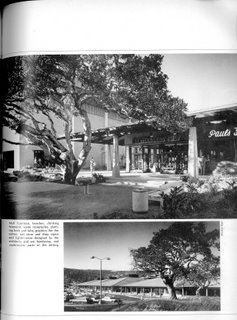Del Monte Center opened its doors in September of 1967, developed by the Dillingham Corporation with a thoughtful and distinctive design by John Carl Warneke & Associates. The landscape, envisioned by Lawrence Halprin & Associates, was equally striking—nearly 100 mature oak trees were preserved on-site, and authentic adobe bricks were used in the construction of the center’s signature 17-foot exposed-beam overhangs. The result was a shopping center that retained the historic charm of Monterey, Northern California’s oldest European settlement.
 |
| The distinctive 17-foot exposed-beam overhangs at Del Monte Center—built from adobe brick and redwood timbers, blending modern retail with regional heritage. |
Architectural Record features Del Monte Center in 1968
So remarkable was the design that Architectural Record magazine highlighted Del Monte Center in April 1968, recognizing its blend of modern commerce with regional authenticity.
 |
| An aerial view of Del Monte Center featured in Architectural Record in 1968—highlighting the bold yet naturalistic design by John Carl Warneke & Associates. |
 |
| Another image from Architectural Record (April 1968), showing Macy’s framed by native trees—testament to the center’s commitment to preserving its natural environment. |
 |
| Del Monte Center’s dramatic overhangs and shaded walkways, celebrated in Architectural Record for their use of regional materials and human-scaled design. |
A mid-century mall that still feels like Monterey
What’s most fascinating is how little has changed since 1967. The original fountain remains, and the center’s layout and aesthetic continue to evoke its mid-century roots. Only a few expansions have altered the original footprint: in 1987, Mervyn’s was added along with an adjoining strip of inline shops; in 2005, a Century Cinemas opened, thoughtfully positioned close enough for seamless dining and shopping before or after a film.
 |
| The original fountain still anchors Del Monte Center—one of the few unchanged elements that continues to define its laid-back charm. |
 |
| Macy’s at Del Monte Center in Monterey, seen from the mall courtyard—opened in 1967 and still serving as a key anchor of the open-air shopping center. |
Sadly, most of the once-abundant oak trees are now gone—often the fate of old growth when roots are slowly choked by layers of concrete and asphalt. Still, the spirit of the place lingers.
While new stores have moved in, many favorites remained, and the atmosphere continued to invite leisurely browsing. The cinema added a new rhythm to the place, drawing in crowds without disrupting the center’s relaxed pace.
And perhaps best of all? After battling the chaos and cramped parking of downtown Monterey, we were welcomed by something increasingly rare: plenty of free parking.
Comments
I had the (mis)fortune to pitch-in on the theater project. Century hadn't decided exactly what they wanted to do at the time, and there was the huge issue of fitting in enough parking, (I hate doing parking plans). Traffic circulation is another huge issue at this center.
BTW, there's a pic of the Magnavox store in the article. This is the first place I remember seeing the Odyssey game console. Crazy to think they expected people to tape transparencies to the front of their TV. :)
I've said this before, but Del Monte is truly a step back in time. Imagine if Bay Fair, Valley Fair, and all the other old outdoor centers had remained in their original formats and were still going strong today with conventional "mall" tenants. That's what Del Monte is.
Sorry, but Stanford's in a different league now. As are places like Fremont Hub and Alameda that, while very nice; are geared toward service and discount retailers. But Del Monte has most of your mainstream tenants that range from mid level to upscale without being too extreme either way.
It's a model that today's "lifestyle" centers might well wish to emulate. The question is would it really work anywhere else but a place like Monterey? In my opinion, had there been a straight freeway connection to Santa Cruz, Salinas, or even San Jose back in '67, Del Monte might not have been even built.
I've only seen one other center like Del Monte and it's in Lihue, HI on the island of Kauai. But like Monterey, it's also a unique situation.
If anyone has this, you can email me at robswindowcleaning at yahoo dot com THANKS!